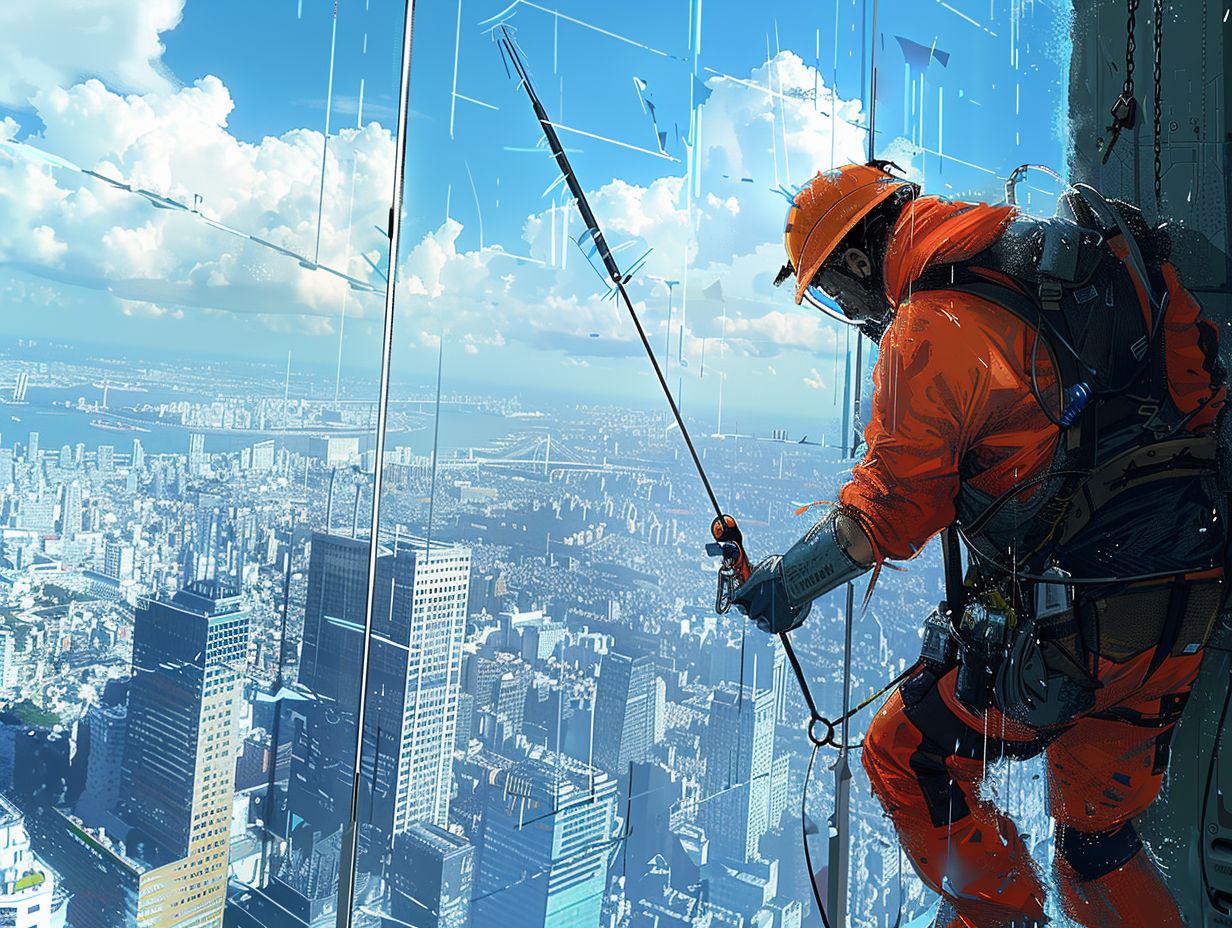Have you ever wondered what a squeegee is and how it can be used in high altitudes?
We will explore the different types of squeegees and the materials they are made of, discuss why precision is crucial in high altitudes, provide techniques for mastering this art, and cover safety precautions.
Let’s dive in and discover the world of squeegees in high altitudes!
What is a Squeegee?

The squeegee is a versatile tool used in various industries, including painting, for the application and removal of liquids or debris on a surface, showcasing the artistry of its functionality.
In addition to its practical uses, squeegees have found their way into the realm of art, particularly in the creation of silk screen prints. Artists use squeegees to evenly distribute ink onto screens, resulting in vibrant and detailed designs. This demonstrates how tools like the squeegee can transcend their traditional roles and inspire creativity.
Squeegees are essential supplies in the cleaning industry, where they are utilized to efficiently clean windows, floors, and other surfaces. Their versatility and effectiveness make them indispensable in various fields, ranging from home maintenance to industrial settings.
What are the Different Types of Squeegees?
Various types of squeegees exist, each designed with specific precision techniques to cater to different applications and surfaces, showcasing the diversity in their utility.
Some common types of squeegees include:
- Window squeegees, which are particularly effective for cleaning glass surfaces due to their rubber blade that efficiently removes water and dirt.
- Floor squeegees, on the other hand, are perfect for pushing and gathering liquids on hard floors, providing an efficient way to maintain cleanliness in commercial spaces.
- Shower squeegees are specifically designed for removing water and soap residue from shower doors and tiles, ensuring a streak-free finish.
Each type of squeegee offers unique features that enhance their efficiency for specific applications.
What Materials are Squeegees Made of?
Squeegees are crafted from a range of materials, each chosen for its precision, durability, and application suitability, reflecting the attention to detail in their construction.
Rubber is a common material used for squeegee blades, offering flexibility and effective cleaning performance. Silicone, known for its chemical resistance, is also popular for its durability.
Some squeegees feature microfiber or foam pads for delicate surfaces. The choice of material significantly impacts the squeegee’s effectiveness in maintaining cleanliness and minimizing maintenance requirements.
It is essential to select the right material based on the specific cleaning task at hand to ensure optimal precision and efficiency in achieving streak-free surfaces.
Why is Precision Important in High Altitudes?
Achieving precision in high altitudes presents unique challenges due to factors like air density and atmospheric conditions, making it crucial for safety and effectiveness during work at elevated locations.
The thin air at high altitudes can affect equipment performance and human physiology, amplifying the need for skillful control and attention to detail. Maintaining precision in such environments requires a deep understanding of how atmospheric conditions impact every aspect of the task at hand. Even minor miscalculations can have major consequences, underlining the importance of meticulous execution in all operations conducted in these challenging settings.
What are the Techniques for Using a Squeegee in High Altitudes?
Mastering the art of using a squeegee in high altitudes requires precise techniques that focus on control, efficiency, and adaptation to the vertical surfaces, emphasizing the importance of skillful execution.
One key technique for effective application in high altitudes is to maintain steady hand-eye coordination for improved precision control. Developing a sense of vertical reach is crucial in tackling challenging spaces while avoiding streaks or missed spots.
As you hone your skills, practice adjusting pressure levels to suit different surfaces, enabling smoother gliding and better cleaning results. Utilizing the correct angle and speed in your movements plays a significant role in achieving a streak-free finish when working on vertical surfaces.
Choosing the Right Squeegee

When working in high altitudes, selecting the appropriate squeegee based on the task requirements, weather conditions, and surface type is essential for optimal performance and safety.
Factors such as the length and flexibility of the squeegee handle, the material of the rubber blade, and the overall weight of the tool can greatly impact its usability in high-altitude settings.
Specialized equipment designed for extreme conditions, such as weatherproofing to withstand harsh outdoor elements or stenciling capabilities for intricate designs on surfaces, can enhance the efficiency of your work.
Always prioritize safety features like non-slip grips and sturdy construction to prevent accidents while working at heights.
By considering these factors, you can ensure that your high-altitude tasks are completed effectively and with precision.
Proper Grip and Stance
Maintaining a secure grip and proper stance while using a squeegee at high altitudes is crucial for stability, control, and safety, requiring the incorporation of climbing gear for added security.
A safety harness should be worn to prevent falls, ensuring that the user maintains balance and control while working at elevated heights. Properly securing the safety harness to a stable anchor point is essential to minimize risks. Climbing gear such as ropes and carabiners can enhance the stability of the worker, allowing them to maneuver confidently within the work area. By prioritizing grip, stance, and safety measures, squeegee operators can effectively carry out their tasks while minimizing the potential for accidents or injuries.
Pressure and Angle Control
Maintaining precise pressure and angle control while maneuvering a squeegee in high altitudes ensures consistent results and efficient coverage, especially in challenging climbing environments.
To achieve optimal results in such conditions, it is crucial to pay attention to the pressure applied on the squeegee against the surface being cleaned. Using extension poles can aid in reaching difficult spots without compromising control. Climbers must be mindful of safety protocols and proper equipment usage.
Quality assurance becomes paramount at high altitudes to prevent any mishaps and ensure thorough cleaning. Skillful adjustment of both pressure and angle while working at heights can lead to impeccable outcomes and project success.
Maintaining Consistent Speed
Consistent speed maintenance while operating a squeegee in high altitudes optimizes efficiency, ensuring smooth application regardless of external factors such as weather conditions that may affect performance.
Maintaining a steady pace during squeegee work is crucial to achieving high-quality results in challenging environments. As the altitude increases, the air becomes thinner, making it essential to adjust your speed to control the flow of the cleaning solution.
This adaptability is key to maintaining the quality of the cleaning process as variations in air pressure can impact the efficiency of the squeegee. By focusing on speed consistency and implementing proper maintenance practices, workers can improve their overall productivity and deliver superior results on windows or other surfaces even in adverse weather conditions.
What are the Safety Precautions for Using a Squeegee in High Altitudes?
Implementing stringent safety precautions when using a squeegee in high altitudes is paramount to mitigate risks associated with climbing, adverse weather, and potential hazards, ensuring a safe and secure working environment.
Incorporating proper risk management strategies is crucial to address the challenges of working at heights efficiently. Maintaining a thorough check on the equipment’s condition and anchorage points, as well as conducting regular safety inspections, are key components of effective risk management. Ensuring that all team members are trained in emergency procedures, such as rope rescue techniques, is essential for responding promptly to unexpected situations. Equipping oneself with appropriate safety gear, including harnesses, helmets, and gloves, is imperative to minimize the dangers inherent in high-altitude squeegee operations.
Proper Gear and Equipment

Utilizing appropriate gear and equipment, including safety harnesses and climbing tools, is vital for ensuring the safety and well-being of individuals working with squeegees at high altitudes.
Prior to engaging in any squeegee operations at elevated locations, thorough preparation and diligence are essential. Before ascending to work areas, workers must double-check their safety harnesses to ensure they are properly secured. Climbing tools, such as ropes and ladders, should also be inspected for any signs of wear and tear. A detailed risk assessment of the site should be conducted to identify potential hazards and establish emergency protocols. By adhering to these safety measures, individuals can mitigate risks and carry out squeegee operations effectively in elevated settings.
Weather and Altitude Considerations
Taking into account weather conditions and altitude considerations is crucial when planning squeegee work in high-altitude environments, requiring adaptability and risk assessment to ensure operational safety.
The interplay of weather elements such as strong winds, sudden storms, and low temperatures can significantly impact the effectiveness and safety of squeegee operations. At higher altitudes, the air tends to be thinner, affecting the drying time of cleaning solutions and the overall visibility during work. To navigate these challenges, squeegee operators need to continuously hone their skill development to handle diverse weather conditions and adapt to the unique characteristics of each location they work in.
Teamwork and Communication
Effective teamwork and communication are essential components of safe squeegee operations in high altitudes, fostering collaboration, coordination, and shared responsibility among team members.
The seamless coordination between team members is crucial when working at elevated locations to ensure the safety of everyone involved in the task. Effective communication plays a key role in understanding each other’s movements and actions, allowing the team to work in harmony without any disruptions. Team members rely on each other to watch their back and provide support, creating a strong sense of shared responsibility for the success of the operation.
Without strong teamwork and communication, the risks involved in squeegee work at high altitudes can increase significantly, underscoring the importance of these aspects in every task.
Frequently Asked Questions
What is the art of the squeegee?
The art of the squeegee refers to the precise and skilled techniques used when cleaning windows or surfaces using a squeegee tool.
Why is precision important in squeegee techniques?

Precision is important in squeegee techniques, especially in high altitudes, because it ensures a streak-free and thorough cleaning of windows or surfaces.
What are some techniques for using a squeegee in high altitudes?
Some techniques for using a squeegee in high altitudes include maintaining a firm grip, using a steady and even stroke, and adjusting the angle of the squeegee to prevent streaks.
How does high altitude affect squeegee techniques?
High altitude can affect squeegee techniques by creating stronger winds, which can make it more difficult to control the squeegee and may require adjustments to be made to the cleaning technique.
What are the benefits of using precision techniques with a squeegee in high altitudes?
The benefits of using precision techniques with a squeegee in high altitudes include achieving a professional and streak-free cleaning, saving time and effort, and improving the overall appearance of windows or surfaces.
Are there any safety precautions to keep in mind when using a squeegee in high altitudes?
Yes, some safety precautions to keep in mind when using a squeegee in high altitudes include using proper safety equipment, being aware of potential hazards, and having a spotter or assistant to assist with stability.




